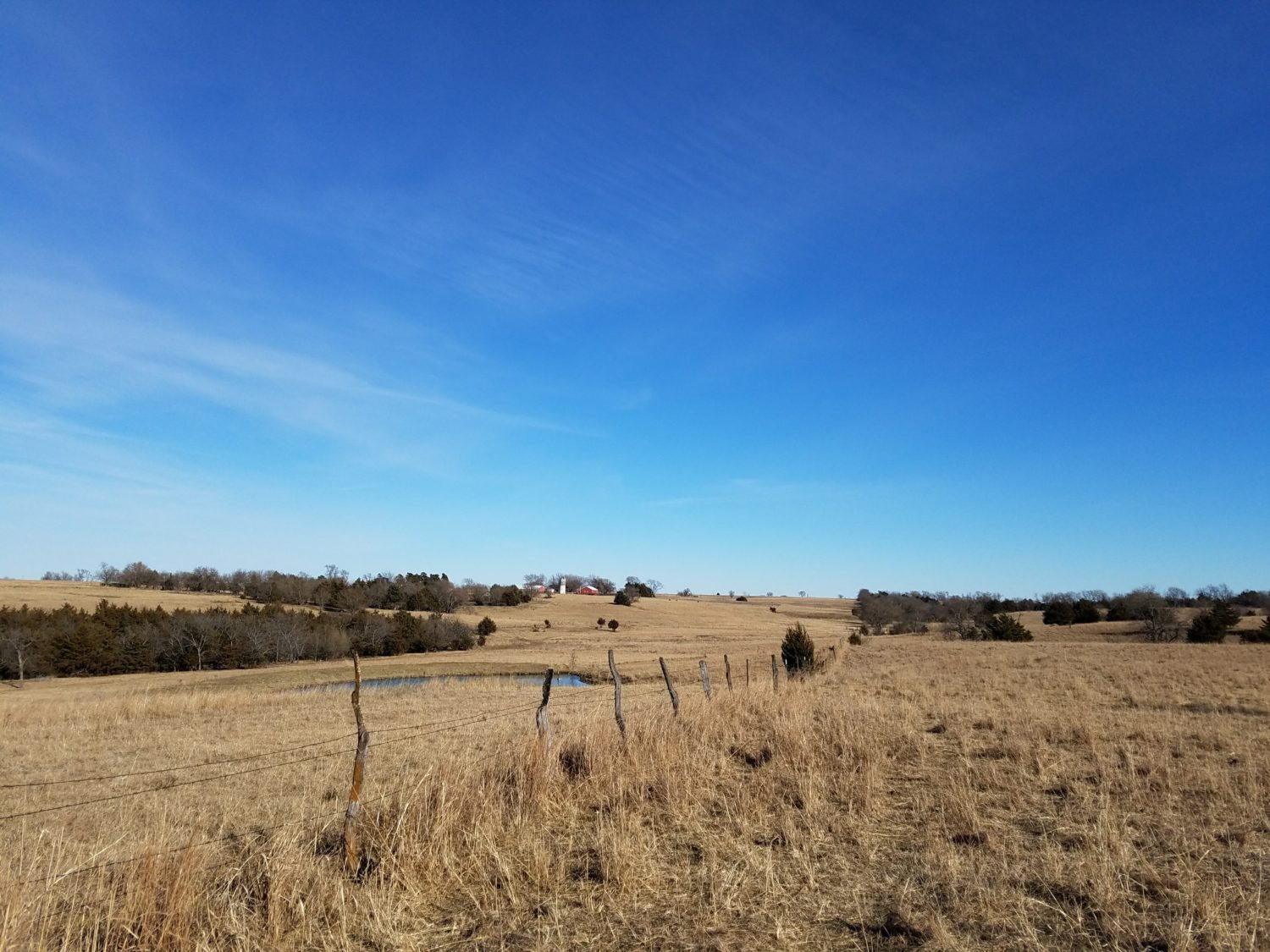Why we (all should) love the perennial: a shift to better living and farming through ecology
Welcome to Kansas: home of the (mostly) former perennial Tallgrass prairie and current corn, wheat and soybean crops
I arrived in Kansas on a foggy January day. Driving from Kansas City to Salina, Kansas provided an introduction to the Eastern Kansas economy and landscape. I learned first of the Civil War —Kansas entering the Union as a “Free State” (a source of great pride) and then of the Dust Bowl and Farm Crisis of more recent history, which left scars on the tight-knit communities and stable, hard-working farm families. We passed through small towns, where the “filling stations” were the gathering spot for farmers at 10 am and 2 pm. It was right out of the movies. Old men in trucker caps and overalls sat in plastic chairs clutching styrofoam coffee cups inside the gas station (hey, I am from California, where we say "gas station") stores. They talked of the weather and the news (of course presidential conversations dominate these days). These gatherings appear casual and inconsequential but have tremendous social influence, I learned. Farmers talk about their yields here. This is where their year’s work is inspected and reviewed by their peers. Many decisions are made. Local news is crafted. We passed through the Flint Hills of Kansas, one of the last remaining native Tallgrass prairie left in our country. It was not plowed because there is a firm bed of limestone right beneath a thin layer of topsoil. It is mainly grazed—and annually burned. I wondered as we drove, a newbie to the mid-west, why the prairie was plowed. Why was it decided that this fertile, vast landscape would grow three crops? Corn. Soybeans. Wheat. There is also sunflowers, the state flower of Kansas, and other grain crops, but the big three dominate. My tour guide, Tallgrass Network Savory hub leader, Julie Mettenburg is a former director of the Kansas Rural Center. She said they always wanted to facilitate landowners chronicling what was produced on their land. What did the settlers plant? What is native? How did that change through the years? Fun fact: sweet potatoes were a big crop here at one time. Around Lawrence, Kansas there is a reemergence of sweet potato production and celebration. Settlers planted fruit trees: apple, cherry, pear and more. Some people are reconnecting with the deep winemaking history in Kansas. Local food scenes are emerging in Ottawa, perhaps to catch up to the mature and thriving scene in Lawrence. New breweries and cafes open. There are restaurants like Limestone Pizza Kitchen Bar where Chef Rick Martin visits local farmers to create a menu of seasonal produce and meat. Julie, myself and Jackie from Central Grazing Company met there for lunch. I had a delightful bunless local burger and a side of spaghetti squash with marinara sauce. It was fresh, warming, light and comforting. I decided I simply love Lawrence, Kansas. Back in Salina, Kansas, Julie and I set up our Savory Network booth at the No Till on the Plains conference trade show. Our “regenerate the grasslands through Holistic Management—and the use of livestock” message stood in a room filled with cover crop seed companies, big farming machines and farming insurance booths, among others.
Back in Salina, Kansas, Julie and I set up our Savory Network booth at the No Till on the Plains conference trade show. Our “regenerate the grasslands through Holistic Management—and the use of livestock” message stood in a room filled with cover crop seed companies, big farming machines and farming insurance booths, among others.  Speakers at the event confirmed Julie’s account of the power of those “filling station” crowds. Crop yields are deeply entwined in a farmer’s pride. For the no-till farmers speaking at and attending this conference, the state of their soil is also a source of pride. This event was my deep dive not only into Midwestern culture but also the practice of cover cropping.
Speakers at the event confirmed Julie’s account of the power of those “filling station” crowds. Crop yields are deeply entwined in a farmer’s pride. For the no-till farmers speaking at and attending this conference, the state of their soil is also a source of pride. This event was my deep dive not only into Midwestern culture but also the practice of cover cropping.
The power of cover cropping
Cover cropping is a method of keeping a living root in cropland at all times to feed the life in the soil. It means there are cover crops planted within main crops like corn and it also can mean that after a crop is harvested, instead of letting the land stand bare and fallow, a cover crop is planted to restore the soil. Cover crop mixes vary by region and intent.What do you need to feed your soil?What are you trying to achieve?Where do you live?The answers will determine your mix. Seed companies are here to help. They will create mixes for you based on your land's specific profile. Some cover crops I learned about at No Till on the Plains and saw at many seed company trade show booths and in presentations are: cowpea, forage collards, turnips, daikon radish, millet, clover, sunflower, sorghum, mung bean and safflower. There are many others. As a newbie to this, I asked Julie what her experience was, as a Kansas native, with cover crops. She said the old-school practice here is using alfalfa (a perennial) in rotations with other cash crops. Traditionally, it used to be put in after several years of the wheat-bean-corn type rotations, as a fixer of nitrogen and restorer of soil. An alfalfa planting will yield good forage or hay for five to seven years, then the land can be put back to cash crops. Dairies especially appreciate alfalfa.
It was exciting to learn of new ways to enhance soil health and fertility. It was great to be in a convention center filled with people who also abhor bare soil. Holistic management considers bare soil an indicator of a broken ecosystem process. It is the first sign of spreading desertification. This short film by Peter Byck shows the impact of cover cropping and livestock on the land: During the Drought from Peter Byck on Vimeo. I learned about the “rule of four” from Jerry Doan, a Holistic Manager, rancher and cover cropper from North Dakota. He said to use a mix of cool season, warm season, broad leaf and grasses in a cover crop mix. He said to leave 50 percent cover in a pasture to feed the soil. Allen Williams , another practitioner using livestock to improve soil health and forage production shared a “principle of three.” He said to have grasses, legumes and forbes in each field. Julie and I made new friends at the Land Institute. Our conversation and focus quickly shifted to perennials. The Savory Institute, with our mission to restore grasslands using properly managed livestock and the Land Institute, with their focus on natural systems agriculture, became quick friends around our common love of the perennial grass. James Bowden, from the Land Institute, arranged for a special tour of the Land Institute for us. We saw the greenhouse filled with plant breeding experiments and the legendary kernza, a perennial grain they developed with an amazing root structure—a giant compared to the roots of annual wheat species. The soil holding ability, water retaining capacity and food source for soil life of perennial species far exceeds that of annuals.
Why perennials are (more) important, according to perennial lovers
Basically it's all about the roots. Perennial plants have deeper, larger root systems which increases soil organic matter. James explained further:“The more soil aggregates we break up through tilling, the more C02 is released into the atmosphere through bacterial respiration. By allowing perennial cover crops to grow, soil organic matter can be increased through root growth. Roots are your primary method of obtaining soil organic matter (SOM). Annual cover crops do not allow enough time for root system development for adequate SOM creation nor do they create an environment where existing SOM can be protected from bacterial digestion. Dr. Ray Weil stated that by tilling, you are destroying micro fauna soil structures such as worm holes. Every time the soil is disturbed, it also disturbs the micro flora and fauna. There has been some discussion about mycorrhizal fungi communication between plants, so it would seem that the more intact a soil is left, the better chance that these micro biomes will continue to function." [gallery type="thumbnails" ids="1807,1806,1805"] We agreed that annual cover crops are far better than bare soil. The conversation didn't end there. We continued, imagining both a past and future with more perennials: given that the Great Plains were once all perennial grasslands, is it true that the full potential of the land cannot be realized until we work with perennials, mimicking the original ecosystem? Timothy Crews from the Land Institute explained that cover crops are generally filling in gaps between food crops, but they can be in place for years. Perennials are typically more difficult to establish than annuals. If left for a few years, the perennial (including kernza) could add a lot of organic matter and condition the soil. Being a grass, kernza does not fix nitrogen, and many (farmers) plant cover crops to improve N fertility with legumes. As Julie suggested, alfalfa is a great choice as a perennial legume.” He noted perennial grass-legume cover crop can be grazed, which is what I also learned from grazing experts Allen Williams and Greg Judy. James added that kernza could be harvested for grain and eventually cut for forage for livestock. So where does this leave us? There is a growing appreciation for farms and ranches that recognize that farms are in fact ecosystems (or part of the one ecosystem that connects us all). This leads to a desire to farm and ranch in nature’s image instead of with “energy-intensive mechanical and chemical inputs,” as stated in a a peer-reviewed paper, by Timothy Crews among others, in the journal Agriculture, Ecosystems and Environment. Could the era of “better living through chemistry” have peaked? Are we collectively realizing that the agroecosystems function poorly compared to the native systems they replaced? The paper by Timothy Crews—as well as our conversation—suggests that we are turning in this direction. My experience at No Till supported this thought. No longer were the Savory Holistic Management folks the crazy kids at the party. People spoke to us with hope. We heard,”this is the way of the future.” Let us together realize, “better living through... ecology!"
The dreams and reality of transitioning to perennial species
My takeaway from the conference speakers and my deeper conversations with Timothy, James and Julie is that biodiversity is best. Use annuals, but mix them with perennials. Have crops but also use livestock as an income source and soil enhancement tool. "I don't really think of perennials as a cover crop, but as a long-term solution to an over-reliance on annuals for our global food system. We have eliminated virtually all of our Tallgrass biome across 10 plus states and into Canada, for what? To grow annual crops,” Julie said.


